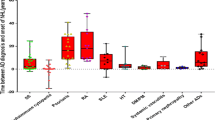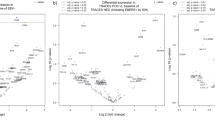Abstract
The diagnosis of adult-onset immunodeficiency syndrome associated with neutralizing anti-interferon γ autoantibodies (AIGA) presents substantial challenges to clinicians and pathologists due to its nonspecific clinical presentation, absence of routine laboratory tests, and resemblance to certain lymphoma types, notably nodal T follicular helper cell lymphoma, angioimmunoblastic type (nTFHL-AI). Some patients undergo lymphadenectomy for histopathological examination to rule out lymphoma, even in the absence of a preceding clinical suspicion of AIGA. This study aimed to identify reliable methods to prevent misdiagnosis of AIGA in this scenario through a retrospective case–control analysis of clinical and pathological data, along with immune gene transcriptomes using the NanoString nCounter platform, to compare AIGA and nTFHL-AI. The investigation revealed a downregulation of the C-X-C motif chemokine ligand 9 (CXCL9) gene in AIGA, prompting an exploration of its diagnostic utility. Immunohistochemistry (IHC) targeting CXCL9 was performed on lymph node specimens to assess its potential as a diagnostic biomarker. The findings exhibited a significantly lower density of CXCL9-positive cells in AIGA compared to nTFHL-AI, displaying a high diagnostic accuracy of 92.3% sensitivity and 100% specificity. Furthermore, CXCL9 IHC demonstrated its ability to differentiate AIGA from various lymphomas sharing similar characteristics. In conclusion, CXCL9 IHC emerges as a robust biomarker for differentiating AIGA from nTFHL-AI and other similar conditions. This reliable diagnostic approach holds the potential to avert misdiagnosis of AIGA as lymphoma, providing timely and accurate diagnosis.



Similar content being viewed by others
Data availability
The datasets generated during and/or analyzed during the current study are available from the corresponding author on reasonable request.
References
Döffinger R, Helbert MR, Barcenas-Morales G, et al. Autoantibodies to interferon-gamma in a patient with selective susceptibility to mycobacterial infection and organ-specific autoimmunity. Clin Infect Dis. 2004;38(1):e10-14. https://doi.org/10.1086/380453.
Höflich C, Sabat R, Rosseau S, et al. Naturally occurring anti-IFN-gamma autoantibody and severe infections with Mycobacterium cheloneae and Burkholderia cocovenenans. Blood. 2004;103(2):673–5. https://doi.org/10.1182/blood-2003-04-1065.
Browne SK, Burbelo PD, Chetchotisakd P, et al. Adult-onset immunodeficiency in Thailand and Taiwan. N Engl J Med. 2012;367(8):725–34. https://doi.org/10.1056/NEJMoa1111160.
Hong GH, Ortega-Villa AM, Hunsberger S, et al. Natural history and evolution of anti-interferon-γ autoantibody-associated immunodeficiency syndrome in Thailand and the United States. Clin Infect Dis. 2020;71(1):53–62. https://doi.org/10.1093/cid/ciz786.
Wu UI, Wang JT, Sheng WH, et al. Incorrect diagnoses in patients with neutralizing anti-interferon-gamma-autoantibodies. Clin Microbiol Infect. 2020;26(12):1684.e1-1684.e6. https://doi.org/10.1016/j.cmi.2020.02.030.
Hase I, Morimoto K, Sakagami T, Ishii Y, van Ingen J. Patient ethnicity and causative species determine the manifestations of anti-interferon-gamma autoantibody-associated nontuberculous mycobacterial disease: a review. Diagn Microbiol Infect Dis. 2017;88(4):308–15. https://doi.org/10.1016/j.diagmicrobio.2017.05.011.
Yuan CT, Wang JT, Sheng WH, et al. Lymphadenopathy associated with neutralizing anti-interferon-gamma autoantibodies could have monoclonal T-cell proliferation indistinguishable from malignant lymphoma and treatable by antibiotics: a clinicopathologic study. Am J Surg Pathol. 2021;45(8):1138–50. https://doi.org/10.1097/PAS.0000000000001731.
Thingujam B, Syue LS, Wang RC, et al. Morphologic spectrum of lymphadenopathy in adult-onset immunodeficiency (anti-interferon-γ autoantibodies). Am J Surg Pathol. 2021;45(11):1561–72. https://doi.org/10.1097/PAS.0000000000001736.
Chi CY, Lin CH, Ho MW, et al. Clinical manifestations, course, and outcome of patients with neutralizing anti-interferon-γ autoantibodies and disseminated nontuberculous mycobacterial infections. Medicine (Baltimore). 2016;95(25): e3927. https://doi.org/10.1097/MD.0000000000003927.
Koizumi Y, Sakagami T, Minamiguchi H, et al. Chylous ascites, anti-interferon-gamma autoantibody, and angioimmunoblastic T-cell lymphoma: a rare but intriguing connection over Mycobacterium avium. Med Microbiol Immunol. 2019;208(1):33–7. https://doi.org/10.1007/s00430-018-0555-0.
Tanigaki T, Kimizuka Y, Maki Y, et al. Development of intravascular large B-cell lymphoma during prophylactic antibiotic treatment for anti-interferon-gamma autoantibody syndrome: a case report. J Infect Chemother. 2022;28(11):1562–6. https://doi.org/10.1016/j.jiac.2022.07.015.
Chen YC, Weng SW, Ding JY, et al. Clinicopathological manifestations and immune phenotypes in adult-onset immunodeficiency with anti-interferon-γ autoantibodies. J Clin Immunol. 2022;42(3):672–83. https://doi.org/10.1007/s10875-022-01210-y.
Cesano A. nCounter(®) PanCancer Immune Profiling panel (NanoString Technologies Inc, Seattle, WA). J Immunother Cancer. 2015;3:42. https://doi.org/10.1186/s40425-015-0088-7.
Benjamini Y, Yekutieli D. The control of the false discovery rate in multiple testing under dependency. Ann Stat. 2001;29(4):1165–88. https://doi.org/10.1214/aos/1013699998.
Subramanian A, Tamayo P, Mootha VK, et al. Gene set enrichment analysis: a knowledge-based approach for interpreting genome-wide expression profiles. Proc Natl Acad Sci U S A. 2005;102(43):15545–50. https://doi.org/10.1073/pnas.0506580102.
Danaher P, Warren S, Dennis L, et al. Gene expression markers of tumor infiltrating leukocytes. J Immunother Cancer. 2017;5:18. https://doi.org/10.1186/s40425-017-0215-8.
R Core Team. R: A language and environment for statistical computing. Published online 2022. https://www.R-project.org/ Accessed 31 Dec 2022.
RStudio Team. RStudio: integrated development environment for R. Published online 2022. http://www.rstudio.com/ Accessed 31 Dec 2022.
Hidekawa C, Yoshimi R, Kishimoto D, et al. Anti-interferon-γ antibody-seropositive disseminated nontuberculous mycobacterial infection mimicking POEMS and TAFRO syndromes. Intern Med. 2022;61(15):2377–85. https://doi.org/10.2169/internalmedicine.8366-21.
Lim M, Chan J, Sandeep, Dave S et al. Nodal TFH cell lymphoma, angioimmunoblastic-type. In: WHO Classification of Tumours Editorial Board. Haematolymphoid Tumours [Internet; Beta Version Ahead of Print]. 5th ed. International Agency for Research on Cancer. https://tumourclassification.iarc.who.int/chaptercontent/63/240 Accessed 30 June 2023.
Campo E, Jaffe ES, Cook JR, et al. The international consensus classification of mature lymphoid neoplasms: a report from the Clinical Advisory Committee. Blood. 2022;140(11):1229–53. https://doi.org/10.1182/blood.2022015851.
Liao F, Rabin RL, Yannelli JR, Koniaris LG, Vanguri P, Farber JM. Human Mig chemokine: biochemical and functional characterization. J Exp Med. 1995;182(5):1301–14. https://doi.org/10.1084/jem.182.5.1301.
Ohmori Y, Schreiber RD, Hamilton TA. Synergy between interferon-gamma and tumor necrosis factor-alpha in transcriptional activation is mediated by cooperation between signal transducer and activator of transcription 1 and nuclear factor kappaB. J Biol Chem. 1997;272(23):14899–907. https://doi.org/10.1074/jbc.272.23.14899.
Muehlinghaus G, Cigliano L, Huehn S, et al. Regulation of CXCR3 and CXCR4 expression during terminal differentiation of memory B cells into plasma cells. Blood. 2005;105(10):3965–71. https://doi.org/10.1182/blood-2004-08-2992.
Rani MR, Foster GR, Leung S, Leaman D, Stark GR, Ransohoff RM. Characterization of beta-R1, a gene that is selectively induced by interferon beta (IFN-beta) compared with IFN-alpha. J Biol Chem. 1996;271(37):22878–84. https://doi.org/10.1074/jbc.271.37.22878.
Qian C, An H, Yu Y, Liu S, Cao X. TLR agonists induce regulatory dendritic cells to recruit Th1 cells via preferential IP-10 secretion and inhibit Th1 proliferation. Blood. 2007;109(8):3308–15. https://doi.org/10.1182/blood-2006-08-040337.
Ohnishi K, Ichikawa A, Kagami Y, et al. Interleukin 4 and gamma-interferon may play a role in the histopathogenesis of peripheral T-cell lymphoma. Cancer Res. 1990;50(24):8028–33.
Pizzolo G, Stein H, Josimovic-Alasevic O, et al. Increased serum levels of soluble IL-2 receptor, CD30 and CD8 molecules, and gamma-interferon in angioimmunoblastic lymphadenopathy: possible pathogenetic role of immunoactivation mechanisms. Br J Haematol. 1990;75(4):485–8. https://doi.org/10.1111/j.1365-2141.1990.tb07786.x.
Gupta M, Stenson M, O’Byrne M, et al. Comprehensive serum cytokine analysis identifies IL-1RA and soluble IL-2Rα as predictors of event-free survival in T-cell lymphoma. Ann Oncol. 2016;27(1):165–72. https://doi.org/10.1093/annonc/mdv486.
Iqbal J, Weisenburger DD, Greiner TC, et al. Molecular signatures to improve diagnosis in peripheral T-cell lymphoma and prognostication in angioimmunoblastic T-cell lymphoma. Blood. 2010;115(5):1026–36. https://doi.org/10.1182/blood-2009-06-227579.
Lee SK, Silva DG, Martin JL, et al. Interferon-γ excess leads to pathogenic accumulation of follicular helper T cells and germinal centers. Immunity. 2012;37(5):880–92. https://doi.org/10.1016/j.immuni.2012.10.010.
Ohshima K, Tutiya T, Yamaguchi T, et al. Infiltration of Th1 and Th2 lymphocytes around Hodgkin and Reed-Sternberg (H&RS) cells in Hodgkin disease: relation with expression of CXC and CC chemokines on H&RS cells. Int J Cancer. 2002;98(4):567–72. https://doi.org/10.1002/ijc.10218.
Goncharova O, Flinner N, Bein J, et al. Migration properties distinguish tumor cells of classical Hodgkin lymphoma from anaplastic large cell lymphoma cells. Cancers (Basel). 2019;11(10):1484. https://doi.org/10.3390/cancers11101484.
Mattoo H, Mahajan VS, Maehara T, et al. Clonal expansion of CD4(+) cytotoxic T lymphocytes in patients with IgG4-related disease. J Allergy Clin Immunol. 2016;138(3):825–38. https://doi.org/10.1016/j.jaci.2015.12.1330.
Guihot A, Oksenhendler E, Galicier L, et al. Multicentric Castleman disease is associated with polyfunctional effector memory HHV-8-specific CD8+ T cells. Blood. 2008;111(3):1387–95. https://doi.org/10.1182/blood-2007-03-080648.
Mumau M, Pierson SK, Gonzalez M, Canna S, Fajgenbaum DC. Serum proteomics identifies interferon gamma signaling in idiopathic multicentric Castleman disease. Blood. 2022;140(Supplement 1):5500–1. https://doi.org/10.1182/blood-2022-167829.
Xie Y, Jaffe ES. How I diagnose angioimmunoblastic T-cell lymphoma. Am J Clin Pathol. 2021;156(1):1–14. https://doi.org/10.1093/ajcp/aqab090.
Acknowledgements
We are grateful for the technical support provided by the Core Labs, Department of Medical Research, National Taiwan University Hospital.
Funding
This study was partially funded by the National Science and Technology Council (110–2314-B-002–247, 111–2320-B-002–023, 111–2314-B-002–145 and 112–2320-B-002–040) and National Taiwan University Cancer Center (NTUCCS-112–07).
Author information
Authors and Affiliations
Contributions
CTY and UIW did conception and design; CTY, WTH, HW, YHP, UIW, JTW, and WHS performed experiment and analysis; CLH did transcriptome analysis; CTY, UIW wrote the paper; YCC, SCC, UIW critical revised the paper.
Corresponding author
Ethics declarations
Ethics Approval
This study was performed in line with the principles of the Declaration of Helsinki. Approval was granted by the Research Ethics Committee of National Taiwan University Hospital (No. 201412163RIND, 202301141RIND).
Consent to participate
Informed consent was obtained from all individual participants in the prospective observational study (No. 201412163RIND). Informed consent was approved to be waived in the retrospective observational study (No. 202301141RIND).
Consent for Publication
Not applicable (there is no personal identity information in the manuscript).
Competing Interests
The authors declare no competing interests.
Declaration of Generative AI and AI-Assisted Technologies in the Writing Process
During the preparation of this work the authors used chatGPT in order to enhance the English quality of the manuscript. After using this tool, the authors carefully reviewed and edited the content as needed and take full responsibility for the content of the publication.
Additional information
Publisher's Note
Springer Nature remains neutral with regard to jurisdictional claims in published maps and institutional affiliations.
Supplementary Information
Below is the link to the electronic supplementary material.
Rights and permissions
Springer Nature or its licensor (e.g. a society or other partner) holds exclusive rights to this article under a publishing agreement with the author(s) or other rightsholder(s); author self-archiving of the accepted manuscript version of this article is solely governed by the terms of such publishing agreement and applicable law.
About this article
Cite this article
Yuan, CT., Huang, WT., Hsu, CL. et al. CXCL9 as a Reliable Biomarker for Discriminating Anti–IFN-γ-Autoantibody–Associated Lymphadenopathy that Mimics Lymphoma. J Clin Immunol 44, 35 (2024). https://doi.org/10.1007/s10875-023-01643-z
Received:
Accepted:
Published:
DOI: https://doi.org/10.1007/s10875-023-01643-z




